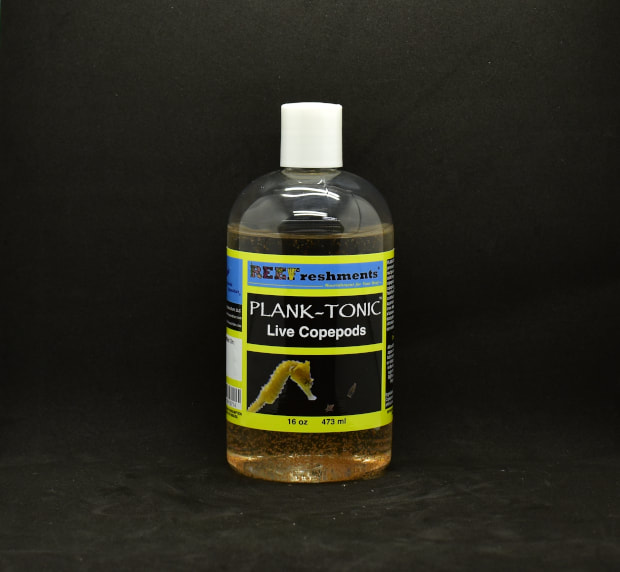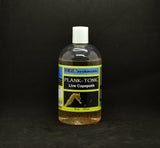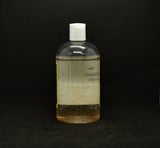- SHOP
- >
- REEFreshments®
- >
- REEFreshments®: PLANK-TONIC™ Live Copepods (16 oz.) - $43.99-$52.99
REEFreshments®: PLANK-TONIC™ Live Copepods (16 oz.) - $43.99-$52.99
SKU:
$52.99
52.99
211.96
$52.99 - $175.96
Unavailable
per item
REEFreshments®: PLANK-TONIC™ Live Copepods is a premium blend of multiple species of both adult and juvenile aquacultured live copepods. Specifically, PLANK-TONIC™ contains three species of copepods: Apocyclops panamensis, Tigriopus californicus, and Tisbe biminiensis. These pods are the perfect food for finicky fish (e.g., dragonets and wrasses) and corals, contribute to an aquarium's clean-up crew through the consumption of detritus and nuisance algae, and help maintain a balanced ecosystem.
REEFreshments®: PLANK-TONIC™ Live Copepods (16 oz.) - priced as low as $43.99
About REEFreshments®: PLANK-TONIC™
PLANK-TONIC™ is one of the only copepod products on the market that contains multiple species of copepods in one package, and every 8 oz. bottle contains the maximum amount of pods permissible without compromising its 6-8 week shelf life. PLANK-TONIC™ is special in that it contains a mix of both harpacticoid and cyclopoid copepods, meaning that fish and carnivorous invertebrates will be able to find food throughout the water column, as some of these copepods are benthic (bottom-dwelling) while others are planktonic (free-swimming). Moreover, every stage of the copepod life cycle is included in our blend (i.e., eggs, nauplii, copepodites, and adults), which is best for establishing or replenishing a copepod culture in the aquarium. With REEFreshments®: PLANK-TONIC™, aquarists can easily culture copepods in the main display, a refugium, or in a separate dedicated system by simply adding our Live Phytoplankton. Please see below for more information regarding culturing your PLANK-TONIC™ Live Copepods.
Directions for Dosing
- Allow bottle to warm to aquarium temperature before dosing.
- Can be used as a broadcast or target feed.
- Can be added directly to display, refugium, or seperate culture vessel.
- We recommend to turn off skimmer(s) and return pump(s) before adding PLANK-TONIC™ and leave this equipment off for 15 minutes to ~2 hours to allow animals to consume the live feeds.
- If you choose NOT to turn off your return pump(s), then we recommend to remove micron filter socks for 24 hours when dosing PLANK-TONIC™.
Shelf Life and Storage Instructions
- Average shelf life of our PLANK-TONIC™ is 6-8 weeks.
- We recommend to REFRIGERATE PLANK-TONIC™ between 33-42˚F.
- Do NOT freeze PLANK-TONIC™!
Instructions for Culturing PLANK-TONIC™ Live Copepod
While our REEFreshments®: PLANK-TONIC™ Live Copepods can be fed directly to your aquarium, some customers may choose to culture the copepods in a separate culture tank for a continuous food source for their aquarium. Instructions for culturing our PLANK-TONIC™ are as follows:
Preparation of Culture Tank:
To culture our copepods, first prepare a culture tank. A culture tank can be anything that holds water -- Even something as simple as a 5 gallon bucket will work. Fill the culture tank with premixed saltwater (specific gravity ~1.024 and temperature of 70F-76F). Add a small sponge filter for aeration/filtration and set it to a light rolling bubble. Add low light.
Adding the Copepods:
Sieve the bottle of PLANK-TONIC™ with a fine mesh sieve or net, and add your sieved copepods to the culture tank. We recommend inoculating new cultures at a ratio of one 8 oz. bottle of REEFreshments®: PLANK-TONIC™ to 2.5 gallons of saltwater.
Feeding the Copepods:
Copepods thrive on phytoplankton and detritus. We recommend adding our REEFreshments®: Live Phytoplankton to feed copepod cultures. Feeding requirements depend on the density of the copepod culture. A good rule of thumb is to add enough phytoplankton to always to keep the water tinted to ensure that the copepods have a continuous microalgae supply.
Maintenance of the Copepods:
Adequate water quality of the culture is of paramount importance. Water quality should be tested on a daily basis and necessary adjustments made accordingly (e.g., maintaining pH). If water analyses indicate a spike in ammonia, nitrite, or nitrate, perform a water change until these parameters are back at ~0ppm.
Copepod Life Cycle:
On average it takes about three weeks for copepods to mature from an egg to an adult. Be patient with your cultures. It may take a few weeks before you observe copepod densities increasing, as the young nauplii are difficult to see with the naked eye.
Preparation of Culture Tank:
To culture our copepods, first prepare a culture tank. A culture tank can be anything that holds water -- Even something as simple as a 5 gallon bucket will work. Fill the culture tank with premixed saltwater (specific gravity ~1.024 and temperature of 70F-76F). Add a small sponge filter for aeration/filtration and set it to a light rolling bubble. Add low light.
Adding the Copepods:
Sieve the bottle of PLANK-TONIC™ with a fine mesh sieve or net, and add your sieved copepods to the culture tank. We recommend inoculating new cultures at a ratio of one 8 oz. bottle of REEFreshments®: PLANK-TONIC™ to 2.5 gallons of saltwater.
Feeding the Copepods:
Copepods thrive on phytoplankton and detritus. We recommend adding our REEFreshments®: Live Phytoplankton to feed copepod cultures. Feeding requirements depend on the density of the copepod culture. A good rule of thumb is to add enough phytoplankton to always to keep the water tinted to ensure that the copepods have a continuous microalgae supply.
Maintenance of the Copepods:
Adequate water quality of the culture is of paramount importance. Water quality should be tested on a daily basis and necessary adjustments made accordingly (e.g., maintaining pH). If water analyses indicate a spike in ammonia, nitrite, or nitrate, perform a water change until these parameters are back at ~0ppm.
Copepod Life Cycle:
On average it takes about three weeks for copepods to mature from an egg to an adult. Be patient with your cultures. It may take a few weeks before you observe copepod densities increasing, as the young nauplii are difficult to see with the naked eye.



